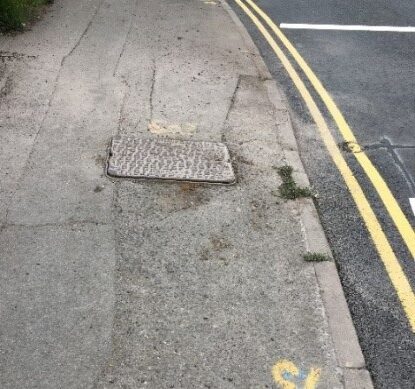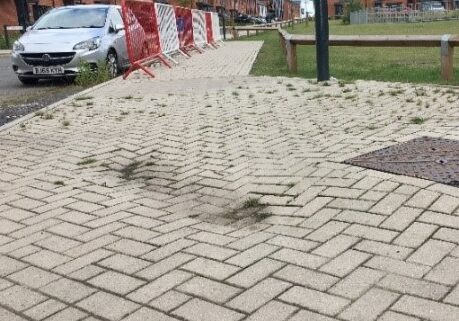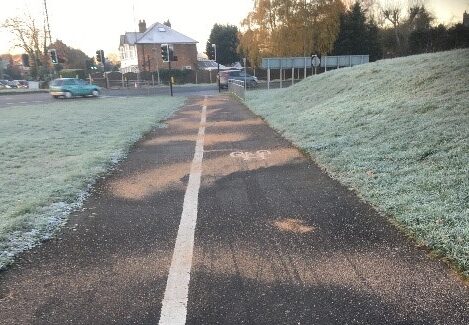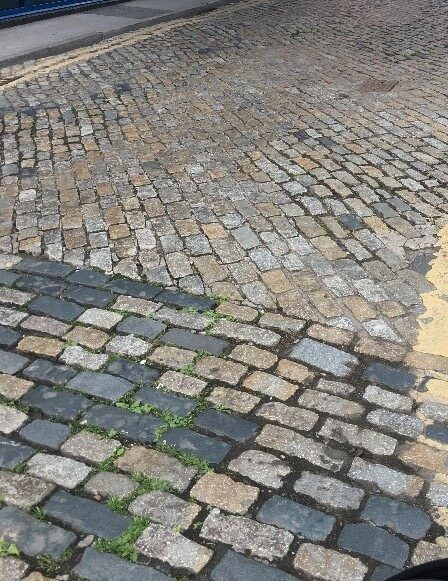Introduction
At Wheels for Wellbeing we’re releasing a series of guidance sheets for local authorities, NGOs, other organisations involved in decisions about walking, wheeling and cycling schemes and for anyone with an interest in active travel infrastructure. Hopefully, these guidance sheets will help explain the reasoning behind different aspects of accessible infrastructure design.
These guidance sheets are aligned with our Guide to Inclusive Cycling (5th edition due autumn 2023). They may be printed, electronically distributed or quoted provided credit is given to Wheels for Wellbeing.
Download the accessible surfaces guidance sheet as a Word document
Download the accessible surfaces guidance sheet as a pdf
Why accessible surfaces?
Accessible surfaces enable everyone to use a space equitably at all times of year. It is essential that public spaces and paths have surfaces which can be used safely.
Accessible surface features:
- Smooth to better than 3mm deflection over 3m lengths;
- Slip-resistant year-round (>50SRV wet pendulum test);
- Drains quickly with 1% installed crossfall;
- Durable –low maintenance, retains quality over 30+ years;
- Resists plant growth – e.g. weeds and moss/algae;
- Hard, not springy – minimises effort to roll or walk on, including for people with balance difficulties;
- Low reflectivity – not shiny;
- Single colour or gentle natural shade variation.
- Does not reach extreme temperatures in either cold or sunny weather;
- Fire resistant – surface will not become unusable in cases where fires (including vehicle arson with fuel/accelerants and/or lithium batteries) occur on the surface;
- Chemical resistant – surface can endure use of rock salt, oil spills, herbicides (some porous surfaces can’t);
- Vandalism resistant – surface cannot be torn or broken.
Best practice surface examples:
- Machine laid asphalt is consistently the best practice surface for cycleways and footways. It is simple to specify with a long history so, with suitable installation, its performance can be guaranteed.
- Concrete (NOT polished concrete) can be a good option for small areas e.g. cycle parking areas.
- New options including resin-bound gravels, recycled material surfaces and innovative “heritage” surfaces are increasingly available. Before specifying any of these surface types, ensure they meet the best practice surface criteria above.
- Other surface types including natural stone, concrete or ceramic pavers of various sizes and self-bound hoggins are frequently used for their aesthetic properties. These surfaces are inherently not as accessible as smooth, unjointed asphalt and will become less accessible as they wear without very rigorous maintenance. We do not recommend their use on cycle paths and footways.

Machine-laid asphalt carriageways often show best practice surface characteristics. Adjacent pavements often show poor reinstatement and vehicle damage.

Even well-laid block paving jolts wheeled mobility users with every joint. It is often installed on substandard bases, causing rapid surface deterioration.

Cycle & pedestrian surfaces must be able to withstand gritting and mechanical maintenance to ensure year-round usability.
Inaccessible surface types:
- Naturally slippery or bumpy surfaces – e.g. riven stone including setts, pavers & kerbs, cobbles, metal, (also hazardous due to extreme heat & cold), polished stone/tile.
- Unbound surfaces–g. gravels, bark chippings, rubber granules, sand, grass, mud etc. Impassable to many Disabled users in many/all weather and maintenance conditions.
- Self-binding surfaces– variable accessibility, can be adequate for most users if very well maintained but will rapidly deteriorate if maintenance reduces or in severe weather conditions.
A note on heritage:
Heritage is often used as an excuse for inaccessibility.
Residents of historic buildings enjoy central heating, electricity and modern sanitation: Historic context is not a good enough reason to install inaccessible surfaces – or to fail to make other relevant access provisions, such as entrance ramps, hearing loops and clear signage.

Many kinds of natural stone surfaces are very bumpy and slippery: They are not accessible.
Legal & guidance position on surfaces:
Equality Act (2010):
These duties are anticipatory:
Section 20: Requires those responsible for a space to anticipate and make reasonable adjustments to enable Disabled people access with no substantial disadvantage compared to non-Disabled people. This explicitly includes altering and removing physical features which would otherwise exclude Disabled people.
Section 149 Public Sector Equality Duty: Requires public authorities to advance equality of opportunity for all people with protected characteristics, including Disabled people.
Cycle Infrastructure Design LTN 1/20:
Summary principle 14: “14) Surfaces must be hard, smooth, level, durable, permeable and safe in all weathers. Surface materials should be easy to maintain, for example asphalt… Materials such as brick and stone should generally be avoided on cycle routes.”
Section 15.2 gives surface specifications and recommends use of a paver machine to give a good finish quality.
References/Further reading/Resources:
- Equality Act (2010)
- LTN 1/20 Cycle infrastructure design
- Wheels for Wellbeing Guide to Inclusive Cycling (4th edition, 2020)
- CIRIA “Safer Surfaces to Walk On” (2006): available free from ciria.org
- Building Regulations part M vol 2
